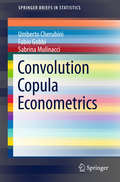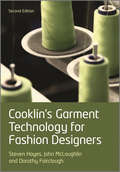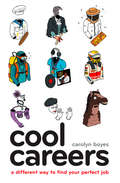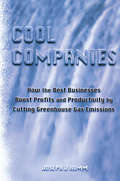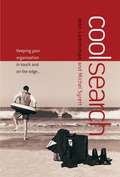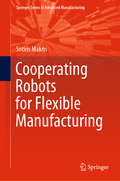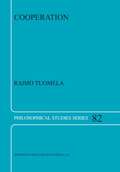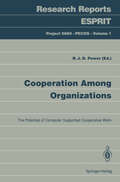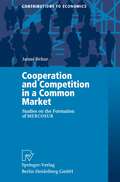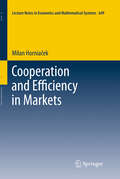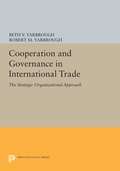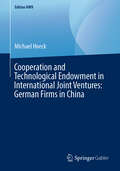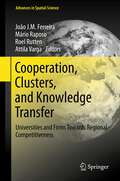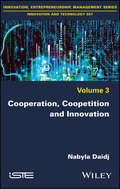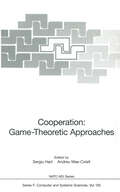- Table View
- List View
Convolution Copula Econometrics (SpringerBriefs in Statistics)
by Umberto Cherubini Fabio Gobbi Sabrina MulinacciThis book presents a novel approach to time series econometrics, which studies the behavior of nonlinear stochastic processes. This approach allows for an arbitrary dependence structure in the increments and provides a generalization with respect to the standard linear independent increments assumption of classical time series models. The book offers a solution to the problem of a general semiparametric approach, which is given by a concept called C-convolution (convolution of dependent variables), and the corresponding theory of convolution-based copulas. Intended for econometrics and statistics scholars with a special interest in time series analysis and copula functions (or other nonparametric approaches), the book is also useful for doctoral students with a basic knowledge of copula functions wanting to learn about the latest research developments in the field.
Cook, Batch, Freeze: Easy Meals To Feed Your Family On A Budget
by Sara LewisCook, Batch, Freeze is the ideal book for anyone looking to save time and money, without scrimping on flavour and nutritious value. By understanding how to make the most of your freezer, by cooking in bulk and freezing leftovers, you can cut down on the cost of your ingredients and the time you spend in your kitchen.
Cook House
by Anna Hedworth*A Sunday Times food book of the year 2019* *A Financial Times Restaurant of the Year 2019* *A Best Food Books of Autumn 2019 pick for the Telegraph* *A Food Book of the Year 2019 for The Week* Have you ever dreamed of quitting your job and starting a business of your own, cooking delicious food to make people smile? Anna Hedworth did. She opened Cook House: an award-winning restaurant housed in two shipping containers. Self-taught chef and proprietor Anna tells the story of how she plucked up the courage to realise her dream – from designing a restaurant, to menu planning, growing her own produce, foraging locally and cooking every day. Cook House is a book filled with more than 100 delicious recipes as well as a story to inspire the millions of others who dream of jumping ship. 'Anna is as impressive in her storytelling as with her food' JEREMY LEE. 'One of my favourite books of the last few years. Recipes I want to cook, things I want to eat... A book that surprised me and delighted me, one that is staying in the kitchen' RACHEL RODDY. 'Anna's food tastes like an idealised version of home to me. I want to cook – and more importantly, to eat – everything in this beautiful book' BEE WILSON. 'Inspiration on every page... This book makes you want to down tools and get cooking' JULIE JONES. 'Anna's enthusiasm bursts from the pages... Cook House made me laugh out loud and hungry. It's brilliant' JAMES WHETLOR.
Cooking on a Bootstrap: Over 100 simple, budget recipes
by Jack MonroeWinner of the OFM Best Food Personality Readers' Award, 2018Jack Monroe is a campaigner, food writer and activist, her first cookbook A Girl Called Jack, was a runaway bestseller. The sequel Cooking on a Bootstrap makes budget food fun and delicious, with 118 incredible new recipes including Fluffy Berry Pancakes, Self-Love Stew, Marmite Mac ‘n’ Cheese and Hot Sardines with Herby Sauce.Chapters include Bread, Breakfasts, A Bag of Pasta and a Packet of Rice, Spuds and Eat More Veg. There are vegan, sweet and what Jack calls ‘contraband’ dishes here, as well as nifty money-saving tips. With her trademark humour and wit, Jack shows us that affordable, authentic and creative recipes aren't just for those with fancy gadgets or premium ingredients.Initially launching this book as a very limited black and white edition on Kickstarter, Jack reached the funding target in just one day. This beautiful edition contains illustrations and original full-colour photographs to really make your mouth water.
Cooklin's Garment Technology for Fashion Designers
by Gerry Cooklin Steven George Hayes John McLoughlin Dorothy FaircloughBuild the knowledge and understanding of garment technology essential to any designer In today's competitive fashion industry, it is essential that designers have a working understanding of garment technology. This 2nd edition has been comprehensively updated, with in-depth information on stitches, guides and attachments and sewing techniques, all of which are fully illustrated. There are enhanced chapters on machine and equipment technology explaining the uses, features and limitations of garment manufacturing equipment, enabling designers to create products that can be manufactured efficiently and with a high degree of quality. Approached from the fashion designer's mindset, this book features illustrations to help users build their knowledge and understanding Blends theoretical and practical material Updated with the latest and most modern advances in clothing technology Illustrated throughout to help shape the reader's knowledge and understanding of garment technology
Cooklin's Garment Technology for Fashion Designers
by Gerry Cooklin Steven George Hayes John McLoughlin Dorothy FaircloughBuild the knowledge and understanding of garment technology essential to any designer In today's competitive fashion industry, it is essential that designers have a working understanding of garment technology. This 2nd edition has been comprehensively updated, with in-depth information on stitches, guides and attachments and sewing techniques, all of which are fully illustrated. There are enhanced chapters on machine and equipment technology explaining the uses, features and limitations of garment manufacturing equipment, enabling designers to create products that can be manufactured efficiently and with a high degree of quality. Approached from the fashion designer's mindset, this book features illustrations to help users build their knowledge and understanding Blends theoretical and practical material Updated with the latest and most modern advances in clothing technology Illustrated throughout to help shape the reader's knowledge and understanding of garment technology
Cool Careers: A Different Way To Find Your Perfect Job
by Carolyn BoyesFind a job that fits you perfectly: don't settle for anything less. You could make money as a City Trader – or make a difference as a Carbon Trader. You could be a Museum Curator or a Spa Reviewer – or if you want to make an impact, how about becoming a Demolition Expert? There's a Cool Career to suit everyone, so get your thinking cap on.
Cool Companies: How the Best Businesses Boost Profits and Productivity by Cutting Greenhouse Gas Emmissions
by Joseph J. Romm'Cool Companies' turns on its head the idea that measures to avert global warming and climate change will pile massive costs on to the industrial sector. It shows how the smartest companies have been able to make money through the improvements that reduce their greenhouse gas emissions. Industry is going to have to adjust to the new tax and regulatory regimes being introduced around the world, aimed at reducing emissions and meeting internationally agreed targets. The more far-sighted companies have recognised the opportunities this offers. Joseph Romm shows how successful they have been in taking them. Romm profiles more than 50 companies, and describes their experiences in the context of their corporate strategies. All are leaders in their sectors and many are household names such as Xerox, Toyota, BP (now BP Amoco), DuPont, Compaq and 3M. They grasped early on the strategic importance of cutting emissions. By working to do so, through increased efficiency, new technologies and improved processes, they have cut their energy costs and boosted their productivity, often dramatically - improvements which translate straight down to the bottom line. The message is clear. Cool Companies - those prepared to overhaul their policies and innovate - are much more likely to thrive in the new climate for business, while those which have to be dragged backwards into the future will face higher costs and tougher competition.
Cool Companies: How the Best Businesses Boost Profits and Productivity by Cutting Greenhouse Gas Emmissions
by Joseph J. Romm'Cool Companies' turns on its head the idea that measures to avert global warming and climate change will pile massive costs on to the industrial sector. It shows how the smartest companies have been able to make money through the improvements that reduce their greenhouse gas emissions. Industry is going to have to adjust to the new tax and regulatory regimes being introduced around the world, aimed at reducing emissions and meeting internationally agreed targets. The more far-sighted companies have recognised the opportunities this offers. Joseph Romm shows how successful they have been in taking them. Romm profiles more than 50 companies, and describes their experiences in the context of their corporate strategies. All are leaders in their sectors and many are household names such as Xerox, Toyota, BP (now BP Amoco), DuPont, Compaq and 3M. They grasped early on the strategic importance of cutting emissions. By working to do so, through increased efficiency, new technologies and improved processes, they have cut their energy costs and boosted their productivity, often dramatically - improvements which translate straight down to the bottom line. The message is clear. Cool Companies - those prepared to overhaul their policies and innovate - are much more likely to thrive in the new climate for business, while those which have to be dragged backwards into the future will face higher costs and tougher competition.
CoolSearch: Keeping Your Organization In Touch and On the Edge...
by Jean Lammiman Michel SyrettThere never has been a time when changes in taste, social outlook and lifestyle have been faster and more fundamental. Coolsearch shows that the revolution that is going on inside the workplace and that which is taking place in the marketplace are two sides of the same coin. Traditional divisions between work and play and between home and the office are being eroded. Twenties-somethings are using their mastery of new technology to transform product development, marketing and merchandising as consumers and ideas generation and decision making as workers. But how can older companies with deeper vested interests and complex hierachies keep in touch with the needs generated by the new generation? Syrett and Lammiman show how street-wise market research, better use of technology, shorter decision making hierarchies, corporate venturing and bottom up leadership has helped a variety of seeming dinosaurs get abreast of the trends. Stories and case studies of companies such as IKEA, GMT, 3M, and L'Oreal and their championing the latest trends and thinking are throughout the book. Coolsearch draws on original research by the authors on how new ideas are inspired and shaped in organisations as well as on interviews with leading thinkers in innovation including London Business School's Costas Markides, Strategos's Gary Hamel and Insead's W Chan Kim and Renee Mauborgne.
Cooperating on Competition in Transatlantic Economic Relations: The Politics of Dispute Prevention (International Political Economy Series)
by C. DamroIn this in-depth study, Damro explains the creation of a formal cooperative framework for preventing disputes in transatlantic competition policy. The findings suggest that, while regulators remain constrained by domestic institutions, they play an important role in explaining why the cooperative framework is largely a discretionary one.
Cooperating Robots for Flexible Manufacturing (Springer Series in Advanced Manufacturing)
by Sotiris MakrisThis book consolidates the current state of knowledge on implementing cooperating robot-based systems to increase the flexibility of manufacturing systems. It is based on the concrete experiences of experts, practitioners, and engineers in implementing cooperating robot systems for more flexible manufacturing systems. Thanks to the great variety of manufacturing systems that we had the opportunity to study, a remarkable collection of methods and tools has emerged. The aim of the book is to share this experience with academia and industry practitioners seeking to improve manufacturing practice. While there are various books on teaching principles for robotics, this book offers a unique opportunity to dive into the practical aspects of implementing complex real-world robotic applications. As it is used in this book, the term “cooperating robots” refers to robots that either cooperate with one another or with people. The book investigates various aspects of cooperation in the context of implementing flexible manufacturing systems. Accordingly, manufacturing systems are the main focus in the discussion on implementing such robotic systems. The book begins with a brief introduction to the concept of manufacturing systems, followed by a discussion of flexibility. Aspects of designing such systems, e.g. material flow, logistics, processing times, shop floor footprint, and design of flexible handling systems, are subsequently covered. In closing, the book addresses key issues in operating such systems, which concern e.g. decision-making, autonomy, cooperation, communication, task scheduling, motion generation, and distribution of control between different devices. Reviewing the state of the art and presenting the latest innovations, the book offers a valuable asset for a broad readership.
Cooperation: A Philosophical Study (Philosophical Studies Series #82)
by R. TuomelaIn Cooperation, A Philosophical Study, Tuomela offers the first comprehensive philosophical theory of cooperation. He builds on such notions a collective and joint goals, mutual beliefs, collective commitments, acting together and acting collectively. The book analyzes the varieties of cooperation, making use of the crucial distinction between group-mode and individual-mode cooperation. The former is based on collective goals and collective commitments, the latter on private goals and commitments. The book discusses the attitudes and the kinds of practical reasoning that cooperation requires and investigate some of the conditions under which cooperation is likely, rationally, to occur. It also shows some of the drawbacks of the standard game-theoretical treatments of cooperation and presents a survey of cooperation research in neighbouring fields. Readership: Essential reading for researchers and graduate students in philosophy. Also of interest to researchers int he social sciences and AI.
Cooperation Among Organizations: The Potential of Computer Supported Cooperative Work (Research Reports Esprit #1)
by Richard J. D. PowerThis book reports research conducted in the ESPRIT project PECOS, which investigated the requirements for effective CSCW (Computer Supported Cooperative Work) with special reference to cooperation among organisations in large projects. It indicates commercial areas where CSCW technology can be applied, and examines such methodological issues as enterprise modelling, system architecture, and the incorporation of artificial intelligence techniques. PECOS studied two practical contexts. The first was the management of a complex industrial project, the construction of a high-speed train for the Italian railway, which required cooperation among four private companies. The second was the design of an information system for water management in the Lombardy region, which required cooperation among several different branches of public administration.fhese contexts were analysed, applying techniques of enterprise modelling, in order to identify requirements for CSCW systems. The composition of the book is as follows. Chapter 1 presents some highlights of the vast literature on cooperation, including results from psycholOgy, sociology, management science, linguistics, and artificial intelligence. Chapter 2 reviews the much shorter history of CSCW, with reference to a catalogue of existing systems given in an appendix at the end of the book. The next four chapters contain our original findings.
Cooperation and Competition in a Common Market: Studies on the Formation of MERCOSUR (Contributions to Economics)
by Jaime BeharThe essays included in this book are the result ofseven years ofresearch spanning the 1990-1997 period. Most of them have been published in scientific magazines or as chapters of books. To the end of this edition, and in order to avoid repetitions, the original texts have been modified, particularly with regard to the titles and introductions ofthe chapters. Chapter two reproduces the article "Economic Integration and Intra-Industry Trade: The Case of the Argentine-Brazilian Free Trade Agreement", published in the Journal of Common Markets (vol XXIX, No 5, pp. 527-552, sept. 1991). Chapter three originates from an empirical study prepared for UNIDO, the United Nations Industrial Development Organization. The analytical framework and the preliminary conclusions of that work appeared in a working paper "The MERCOSUR Pattern of Intra-Industry Trade" (RP No 75, Stockholm: LAIS, 1997). Chapter four was published with the title "Plant-size Effects ofTrade: The Case of MERCOSUR Countries" as a chapter of the book Growth Trade and Integration in Latin America (W. Karlsson and A. Malaki (eds. ), Stockholm: LAIS, pp. 297-319, 1996). Chapter five in tum corresponds to the article entitled "Measuring the Effects of Economic Integration for the Southern Cone Countries: Industry Simulations of Trade Liberalization" as published in The Developing Economies (Vol. XXXIII, No 1, pp. 1-31, mars 1995). Finally, chapter six is the revised and updated version of the paper presented at the First European Congress ofLatinamericanists, which took place at Salamanca, Spain in June 1996.
Cooperation and Efficiency in Markets (Lecture Notes in Economics and Mathematical Systems #649)
by Milan HorniačekThe book deals with collusion between firms on both sides of a market that is immune to deviations by coalitions. We study this issue using an infinitely countably repeated game with discounting of future single period payoffs. A strict strong perfect equilibrium is the main solution concept that we apply. It requires that no coalition of players in no subgame can weakly Pareto improve the vector of continuation average discounted payoffs of its members by a deviation. If the sum of firms' average discounted profits is maximized along the equilibrium path then the equilibrium output of each type of good is produced with the lowest possible costs. If, in addition, all buyers are retailers (i.e., they resell the goods purchased in the analyzed market in a retail market) then the equilibrium vector of the quantities sold in the retail market is sold with the lowest possible selling costs. We specify sufficient conditions under which collusion increases consumer welfare.
Cooperation and Enlargement: Two Challenges to be Addressed in the European Projects—2022 (Studies in Systems, Decision and Control #500)
by Ghislaine Pellat Jovan Zafiroski Marian ŠuplataIn this book, the ERECO-PGV[1] network wishes to make an overview of the cooperation implemented by and in the European Union and to describe the concrete forms they have taken. The issue is to analyze the internal European cooperation between economic actors, politicians, and EU citizens at different levels, but also to focus attention on the external cooperation (neighborhood policies, external policies, and collaborations with international institutions: NATO, OECD, WTO, etc.). Carrying uncompromising attention on this issue means rethinking the European project in light of today's challenges.From the very beginning, the EU was based on and called for forms of multinational cooperation, bilateral (internal and external) at different levels, involving economic actors, public actors, local authorities, and civil society. The frameworks for this cooperation as well as for the successive enlargements of the EU were drawn up in the context of European negotiations, in particular during discussions on the European Treaties. European values, standards, and rules are embodied in the texts of agreements, resolutions, and European directives and Treaties signed by all member countries. They establish the functioning of European institutions and the framework of democratic life in Europe.The emergence of current crises (Brexit, COVID-19, migration crisis, non-respect of rule of law rules, refusal of certain member countries to apply the European Charter of Human Rights, etc.) is questioning the project of the European Union and introduced the challenges which should be overcome by the proposal of the new project able to face the internal complexity of the Union and to answer to the pressure of a conflicting international context. What remains of the European ideal affirmed in the treaties of 1957, 1992, and 2007? How to "re-enchant" the common project? Yet, the European Union remains attractive to new candidate countries. How do they read the integration conditions into the EU with regard to their own projects?
Cooperation and Governance in International Trade: The Strategic Organizational Approach (PDF)
by Beth V. Yarbrough Robert M. YarbroughInternational trade liberalization historically has taken many organizational forms--unilateral, bilateral, minilateral, and multilateral. Given the proliferation of normative views about which of these should be pursued, economists and political scientists have devoted surprisingly little attention to the reasons for the observed variation in the chosen forms. This book is the first to develop a single theoretical framework to account for past liberalization practices and also to anticipate ongoing changes in the international organization of trade policy. Growing out of a multidisciplinary effort combining economics, politics, organization, and law, the book's strategic organizational approach will interest students of trade, international relations, or institutional arrangements. Central to the strategic organizational approach is the view that organizational variety reflects alternate governance structures used to facilitate and enforce agreements. Among the successes of the approach are explanations of unilateral liberalization by nineteenth-century Britain, U.S. governance of multilateral liberalization under the early postwar GATT, growing use of bilateral governance to limit nontariff trade barriers, and anticipation of major moves toward minilateral governance, such as Europe/1992 and the Canada-U.S. Free-Trade Agreement.Originally published in 1992.The Princeton Legacy Library uses the latest print-on-demand technology to again make available previously out-of-print books from the distinguished backlist of Princeton University Press. These editions preserve the original texts of these important books while presenting them in durable paperback and hardcover editions. The goal of the Princeton Legacy Library is to vastly increase access to the rich scholarly heritage found in the thousands of books published by Princeton University Press since its founding in 1905.
Cooperation and Technological Endowment in International Joint Ventures: German Firms in China (Edition KWV)
by Michael HoeckA frequent choice for market entry to China is the international joint venture (IJV) with a Chinese partner. This is regarded as an adequate market entry if complex technological knowledge is to be transferred to the new location. However, IJVs also represent an easy way for local partners to absorb technological knowledge without authorization.Michael Hoeck investigates the character and the degree of technology transfer into IJVs, using the example of German industrial firms in China. The two central questions that are investigated are „What factors influence the sophistication of the technological endowment that an IJV in China receives from its German parents?“ and „In what way do strategic considerations regarding inter-firm cooperation and knowledge sharing influence the foreign investor’s technology transfer behaviour?“.The study results – derived from theoretical and empirical analysis – presents novel insights to both researchers and practitioners.
Cooperation Between Antitrust Agencies at the International Level
by Bruno ZanettinThe issue of international antitrust enforcement is high on the agenda for both developed and developing countries. Bilateral cooperation between antitrust agencies, in particular the European Commission and US agencies, is the focus of this new work. It first shows how bilateral cooperation was developed as a response to the limits of the unilateral and extraterritorial application of national competition laws, and how it has evolved from an instrument initially designed to avoid conflicts into a tool aimed at coordinating joint investigations of international competition cases. It then considers how bilateral cooperation could be used optimally, by analysing two forms of advanced cooperation: the exchange of confidential information, and positive comity, which is the only satisfactory answer competition law can provide to market access cases. It shows that the use of such instruments is limited by significant legal and political obstacles, even in the context of the exemplary EC US relationship.The book therefore argues that the efficient use of bilateral cooperation will be limited to a small number of well-established competition agencies. If international anticompetitive practices are to be efficiently addressed by an increasingly large and heterogeneous group of competition agencies, horizontal cooperation between antitrust agencies must be complemented by a multilateral and supranational solution going beyond proposals currently put forward. The book concludes that only the WTO and its dispute settlement system could provide the basis for such a system.
Cooperation Between Companies and Non-profit Organizations: Taking Responsibility Together: Guidelines for Constructive, Credible and Transparent CSR Projects
by Gabriele Faber-Wiener Bettina GjecajThis book describes how cooperation between companies and non-profit organizations can be successfully structured. Companies want and need to take on more social responsibility, and joint projects with non-profit organizations are therefore more in demand than ever. This is not about maximizing profits through greenwashing or token commitments, but about serious corporate social responsibility projects and purpose strategies that strengthen the reputation on both sides. This requires a structured, transparent approach from the outset.The authors explain the theoretical basis and provide practical guidance on how the initiation of cooperation projects can lead to a credible and sustainable collaboration with added value for all stakeholders. An elementary part of the book is the "Code for Transparent Cooperation", a proven framework that can be applied directly in practice.A book for CSR, communication, marketing and compliance managers in companiesand non-profit organizations who strive for clear rules and an open dialogue at eye level.Anyone who acts as a credible driver of transformation would do well to operate sustainably themselves. Transparency creates credibility and reliability. The more an organization's goals shape the design of partnerships with companies, the more authentic they can appear to the outside world. This guide provides helpful tips and orientation on how to achieve coherence.Dipl.theol. Yvonne Zwick, Chairwoman of B.A.U.M. e.V. - Network for Sustainable Management, HamburgNon-profit organizations are central pillars of our society. Especially in times of disruption and change, their performance is of increasing importance. The prerequisite for this is independence - also in cooperation with companies. This book helps companies and non-profit organizations to understand their counterparts and establish stable collaborations.Dr. Günther Lutschinger, Managing Director of Fundraising Association Austria, ViennaThe time for lone wolves is over. If we are to achieve the Paris climate targets, companies must offer profitable solutions for people and the planet. It's all about: How do I tackle it? The new book by Gabriele Faber-Wiener and Bettina Gjecaj focuses in particular on partnerships with non-profit organizations and aims to prepare the ground for successful collaboration.Daniela Knieling, Managing Director respACT and Network Representative Global Compact Network Austria, ViennaCredibility, responsibility and transparency are the guarantee and basis for the sustainable development of companies. A thriving, trusting cooperation between companies and non-profit organizations helps to answer political and social questions and is a profound approach to solving complex ecological problems.Ernst Ternon, MBA MSc MSc, Head of Green Marketing, Wieselburg Campus, Wiener Neustadt University of Applied Sciences
Cooperation, Clusters, and Knowledge Transfer: Universities and Firms Towards Regional Competitiveness (Advances in Spatial Science)
by João J. M. Ferreira, Mário Raposo, Roel Rutten and Attila VargaCooperation and clusters have become the guiding paradigms for explaining and promoting regional competitiveness, but the cooperation process between firms and universities and the transfer of knowledge in guiding and nurturing regional competitiveness has received relatively little attention. This book strives to fill this gap in highlighting the connection between inter-firm cooperation in regional clusters, innovation and regional networks, and the role of universities in them . It goes beyond the traditional economic approach of clusters and includes ‘soft factors’ in the explanation of regional competitiveness, and connects the literature on clusters to the literature of learning and knowledge creation as sources of regional competitiveness. It aims to foster an international and interdisciplinary exchange of perspectives by presenting current developments, case studies, best practices as well as new integrated theoretical approaches and applications.
Cooperation, Coopetition and Innovation
by Nabyla DaidjIn presenting the concepts and the logical structure of the reasoning offered by game theory and their applications, the book explains the rational process of decision making in the framework of firm management and market competition. The book will expose both general teachings and a comprehensive analysis applied to specific case studies of various sectors of the economy.
Cooperation, Coopetition and Innovation
by Nabyla DaidjIn presenting the concepts and the logical structure of the reasoning offered by game theory and their applications, the book explains the rational process of decision making in the framework of firm management and market competition. The book will expose both general teachings and a comprehensive analysis applied to specific case studies of various sectors of the economy.
Cooperation: Game-Theoretic Approaches (NATO ASI Subseries F: #155)
by Sergiu Hart Andreu Mas-ColellIssues relating to the emergence, persistence, and stability of cooperation among social agents of every type are widely recognized to be of paramount importance. They are also analytically difficult and intellectually challenging. This book, arising from a NATO Advanced Study Institute held at SUNY in 1994, is an up-to-date presentation of the contribution of game theory to the subject. The contributors are leading specialists who focus on the problem from the many different angles of game theory, including axiomatic bargaining theory, the Nash program of non-cooperative foundations, game with complete information, repeated and sequential games, bounded rationality methods, evolutionary theory, experimental approaches, and others. Together they offer significant progress in understanding cooperation.
